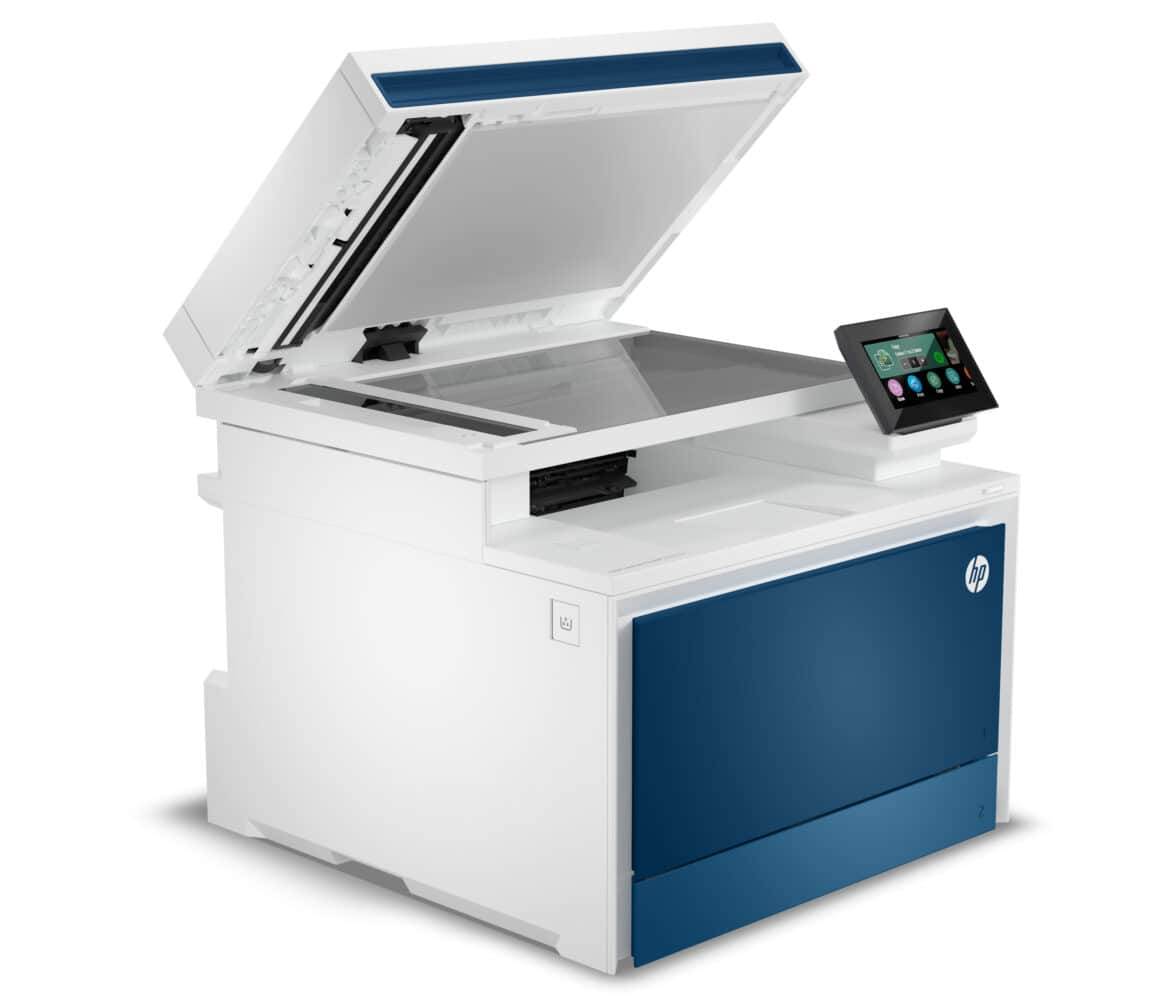HP continues to evolve its laser portfolio – and the software and services around it – to keep up with today’s needs and requirements.
There is still plenty of interesting things happening in the printer market in 2023. You might not expect that at first, because printers and MFPs don’t really have the reputation of being on the bleeding edge of technological developments. However, after speaking with Hans van Barel, Print Category Manager/Lead at HP for the Benelux, it is clear that this market still has plenty of challenges and growth opportunities for the company. Partly this has to do with changing global conditions, partly also with the underlying technology. We take a closer look at that in this article.
Laser is the technology for business applications
The printer market has seen an interesting development over the past 10-15 years. We have been following this market for at least that long and have seen things shift quite a bit. One of the developments was the emergence of inkjet printers and MFPs for business environments. At HP, these were the PageWide models. These had a page-wide printer head with lots of nozzles, which made it possible to match the print speed performance of laser printers.
These models from HP, and similar devices from competitors, were promised a great future. Yet two years ago, HP decided to pull the plug on this division. Not because it wasn’t successful, Van Barel points out, but because the differences with laser were becoming too small. “There should be sufficient reason to manage two portfolios, they should be sufficiently distinct from each other,” he indicates. When HP entered this market in 2012/2013, the difference between these types of inkjets and laser printers was very large in terms of cost and power consumption. “That difference had become too small, so all the focus and innovation today is on laser,” Van Barel articulates HP’s conclusion. Ink is for consumers, with a little bit of small business focus added to it with the OfficeJet products.
Catching up in sales
Now that we are clear where the focus of HP’s printing division lies, we can look at today’s developments. Catching up is the term that immediately comes to mind for Van Barel. Especially in the entry-level segment for laser printers and MFPs, there has been little availability in recent years. This was the case for the best-selling model in this price range, the LaserJet Pro MFP M479. The reason for this was that there were shortages of raw materials and parts. Late last year, however, this popular model became broadly available again, after which they were selling like hot cakes. Meanwhile, this model has been succeeded by the LaserJet Pro MFP 4202/4302, about which you will soon be able to read an extensive review on our website.
In addition to the end of parts shortages, there was obviously something else at play, namely hybrid working. After covid, there was a prime opportunity to supply offices and home offices with new equipment. As an overarching trend, then, Van Barel sees strong growth in color MFPs, as well as smaller black-and-white models. The former will find their way more into office environments, the latter perhaps more into home offices.
All in all, Van Barel notes trends that are having a positive impact on the market. Hybrid working won’t go away either, is his belief. He also sees offices getting fuller again, but “something has changed permanently.” Even if an employee only works from home two out of five days, they may need a printer or MFP. Mind you, he doesn’t see any large projects coming along in which organizations buy home office printers in bulk. These sales are more of an ad hoc affair, through reseller Web shops. But the sales figures don’t lie, models targeting home workers are on the rise as are models for use in the office.
Article continues after the box below
HP Smart
When you say printer or a multifunctional, you also say driver. Without it, peripherals don’t function if you want to use them through a computer. A very long time ago, you had to manually install a driver for most if not all peripheral components, like monitors. Nowadays, however, almost everything already works without these kinds of drivers, which you have to install yourself. “Actually, the classic driver is no longer of this time,” Van Barel states. At HP, they solved this by developing HP Smart. That is an application that you can find on a Windows machine in the Microsoft Store. This is basically the driver and management application in one. HP pushes most users in small and medium environments to this application. In large environments, the universal driver still rules, even though Van Barel is already seeing a shift toward HP Smart there as well.
Catching up for managed print
In addition to the catch-ups that are more or less happening to HP (as demand increases due to external factors), it also needs to actively play catch-up itself. “Managed print needs catching up, to match how people work,” Van Barel points out. People work across multiple locations, but the print server is often still the only application running locally within the company. “That doesn’t make sense, it is perfectly possible to run it in the cloud,” he states. He also sees some room for improvement in the area of scanning: “Scanning still often defaults to email, not to a cloud environment.” To make matters worse, a scan attached to an email is often printed by the recipient. That’s not exactly sustainable, something HP has long been committed to, or at least very vocal about, as evidenced by the many annual reports around ESG it has already produced.
Another area where Managed Print Services (MPS) need to catch up is in the area of endpoint security. HP itself, under the umbrella of The Wolf, is already doing quite a bit about that. For example, HP business printers check the integrity of the BIOS and hardware. Depending on which line you purchase, a golden copy of the firmware is also stored airgapped on the machine. That way, a printer can always restore itself, too.
Recovering from a golden copy, however, is something you need a machine from the Enterprise line for. The LaserJet Pro line does not offer it. The same goes for Memory Shield, which allows HP to counter buffer overflow attacks. Those are the most common attacks on printers. We wrote an article about this a couple of years ago. The reason this is not on the Pro line has to do with the chips and other hardware used. So this technology will undoubtedly trickle down from Enterprise to Pro over the years.
In addition, the service model of MPS needs to be made smarter, Van Barel believes. This can be done by using Big Data and Machine Learning algorithms. “That’s where HP has brought innovation to the MPS market with our HP Smart Device Services solution,” according to Van Barel. This solution allows customers to monitor printers remotely. Based on the AI engine, it can then predict failures. A technical person can then fix the problem even before a user is affected.
All in all, MPS suffers somewhat from the law of diminishing returns, according to Van Barel. “MPS was actually ahead, because it was 15 years ahead of the subscription world. Now, however, it is being caught up in this regard.” There is currently no subscription option for MPS. No doubt that will change in the future, but HP still has some steps to take.
Sustainability
It is virtually impossible to have a conversation about printers and printing without talking about sustainability. So that is a major focus point for the new LaserJet Pro 4202/4302 line that we also talked about briefly above. As part of the new line, HP also introduces new toner to the market. Toner plays a crucial role in the energy consumption of a laser printer. The printer has to melt it, otherwise the powder doesn’t stick to the paper. The lower this melting temperature can be, obviously without negatively affecting the quality of the prints, the less energy the printer consumes.
In 2015, we attended an event by HP where such a reduction in melting temperature was the big news. Now, eight years later, HP has taken the next step with TerraJet toner. This reduces the temperature further still. This results in significant energy savings, according to HP. It claims a 27 percent reduction in energy consumption during printing. In addition, the cartridges have become smaller. This reduces packaging waste.
The lower melting temperature also has a positive effect on the machine’s warm-up time. That means the first print is out faster. That in itself is not hugely interesting anymore, because the number of pages per minute is not as distinctive as it used to be. More interesting is that a lower melt temperature should make for better color reproduction. In general, a lower temperature allows for richer colors.
In itself, the above is important if an organization wants to have as small a footprint as possible. However, Van Barel is also realistic, and states that most of the footprint from a printer or MFP comes not from the technology and the machines themselves, but from the paper that they use. On that point, then, it is pertinent to note that this new entry-level laser line is the first from HP to be sold only as a duplex model. That is, on all available models you can print double-sided by default. That was not the case until the previous line in this price range. HP is also encouraging the use of pull printing. Not only because this has a higher degree of security, but also because it makes you print more consciously.
Lots of innovation, also in the future
All in all, it is clear that many interesting things are happening in the printing market. HP owes it to its status as a leading supplier in this market to take the lead. It is doing just that. In particular, the new TerraJet toner steals the show as far as we are concerned. The company also takes its security responsibilities seriously, which also remains important. We can expect a lot of focus from HP on revamping and modernizing its MPS offering in the near future. In other words, more innovation is on its way. HP can’t afford to stand still, even in a market which – from the outside – doesn’t seem to move very quickly.


